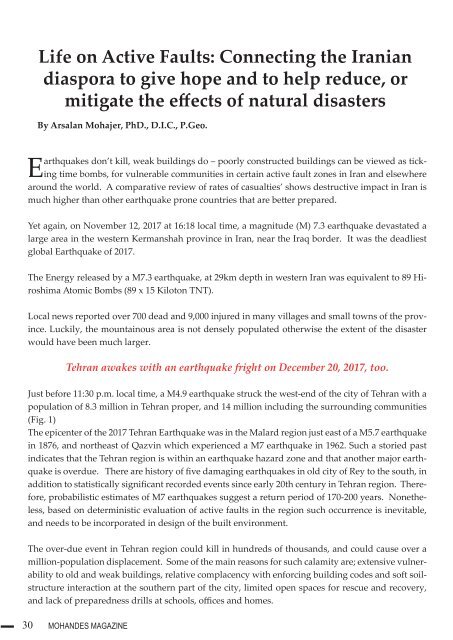Mohandes Magazine Fall-Winter Edition 2018
Create successful ePaper yourself
Turn your PDF publications into a flip-book with our unique Google optimized e-Paper software.
Life on Active Faults: Connecting the Iranian<br />
diaspora to give hope and to help reduce, or<br />
mitigate the effects of natural disasters<br />
By Arsalan Mohajer, PhD., D.I.C., P.Geo.<br />
Earthquakes don’t kill, weak buildings do – poorly constructed buildings can be viewed as ticking<br />
time bombs, for vulnerable communities in certain active fault zones in Iran and elsewhere<br />
around the world. A comparative review of rates of casualties’ shows destructive impact in Iran is<br />
much higher than other earthquake prone countries that are better prepared.<br />
Yet again, on November 12, 2017 at 16:18 local time, a magnitude (M) 7.3 earthquake devastated a<br />
large area in the western Kermanshah province in Iran, near the Iraq border. It was the deadliest<br />
global Earthquake of 2017.<br />
The Energy released by a M7.3 earthquake, at 29km depth in western Iran was equivalent to 89 Hiroshima<br />
Atomic Bombs (89 x 15 Kiloton TNT).<br />
Local news reported over 700 dead and 9,000 injured in many villages and small towns of the province.<br />
Luckily, the mountainous area is not densely populated otherwise the extent of the disaster<br />
would have been much larger.<br />
Tehran awakes with an earthquake fright on December 20, 2017, too.<br />
Just before 11:30 p.m. local time, a M4.9 earthquake struck the west-end of the city of Tehran with a<br />
population of 8.3 million in Tehran proper, and 14 million including the surrounding communities<br />
(Fig. 1)<br />
The epicenter of the 2017 Tehran Earthquake was in the Malard region just east of a M5.7 earthquake<br />
in 1876, and northeast of Qazvin which experienced a M7 earthquake in 1962. Such a storied past<br />
indicates that the Tehran region is within an earthquake hazard zone and that another major earthquake<br />
is overdue. There are history of five damaging earthquakes in old city of Rey to the south, in<br />
addition to statistically significant recorded events since early 20th century in Tehran region. Therefore,<br />
probabilistic estimates of M7 earthquakes suggest a return period of 170-200 years. Nonetheless,<br />
based on deterministic evaluation of active faults in the region such occurrence is inevitable,<br />
and needs to be incorporated in design of the built environment.<br />
The over-due event in Tehran region could kill in hundreds of thousands, and could cause over a<br />
million-population displacement. Some of the main reasons for such calamity are; extensive vulnerability<br />
to old and weak buildings, relative complacency with enforcing building codes and soft soilstructure<br />
interaction at the southern part of the city, limited open spaces for rescue and recovery,<br />
and lack of preparedness drills at schools, offices and homes.<br />
30 MOHANDES MAGAZINE






